| Diese Seite auf Deutsch! |
Freshwater SnailsPart 1: Gill-Breathing Snails |
|
|
|
 |
||||||||||||||||||||||||||||||||
| Number of species in Mollusca, displayed by classes, including percentage. Sources: WoRMS: MolluscaBase eds. (2025): Mollusca LINNAEUS, 1758. | |||||||||||||||||||||||||||||||||
Snails and bivalves are the only mollusc classes that are not restricted to the sea: they can also be found in freshwater habitats, such as rivers and streams, lakes, ponds and springs. The conditions in these environments differ fundamentally from the relatively stable marine habitat: inland waters are subject to strong fluctuations in temperature, water level, current and chemical composition. This poses special challenges for the organisms living there.
Also, freshwater habitats are often highly fragmented: many are isolated from each other, which promotes genetic divergence between populations and, in the long term, can lead to the emergence of new species through adaptive radiation. These processes have contributed – as they have on land – to a high level of species diversity among freshwater snails and bivalves.
Compared to other mollusc classes, which are entirely marine, gastropods are by far the most speciose group, with around 73,000 described extant species (as of 2024), roughly one third of which do not live in the sea. Among the approximately 20,000 known species of bivalves, a significant number also inhabit freshwater. All other molluscan classes – such as chitons, tusk shells or cephalopods – are found exclusively in marine environments.
It is remarkable that the freshwater gastropods known today belong to very different systematic groups. Some, such as the common river nerite (Theodoxus fluviatilis: Neritidae), are closely related to marine forms like Nerita or Clithon, as well as to the land-dwelling Helicinidae. All of these belong to the major clade Neritimorpha. Others, such as river snails (Viviparidae) and Bithynia snails (Bithyniidae), are more closely related to marine periwinkles (Littorinidae). Like the terrestrial operculate round mouth snails (Pomatiidae), they belong to the vastly diverse clade Caenogastropoda.
This leads to the conclusion that the transition from marine to freshwater habitats occurred multiple times independently within the gastropods. As a consequence, this also explains the remarkable diversity in form and ecology among freshwater-dwelling snails (limnic gastropods). The present first part of the page will focus on the freshwater snails breathing with gills, followed by a second part on freshwater snails breathing with lungs.
![]() Marine Gastropods:
Systematics and Diversity.
Marine Gastropods:
Systematics and Diversity.
![]() How Did Snails Come to Live on Land?
How Did Snails Come to Live on Land?
 River nerite (Theodoxus sp.): Danube island, Vienna. Picture: Thomas Bernhard (iNaturalist). |
 Hot spring snails in the Bükk Mountains (Hungary). Picture: Alexander Mrkvicka (iNaturalist). |
Among the most remarkable features of the Neritimorpha is the wide range of habitats in which they occur: from marine intertidal zones and brackish waters to freshwater, and in some cases even on land: The shells of the mainly tropical family Helicinidae often resemble those of more "typical" land snails (Pulmonata), yet they are only distantly related: Helicinidae possess an operculum, only two tentacles, are dioecious (with separate sexes), and are in fact much more closely related to the freshwater and marine Neritidae.
![]() Marine Gastropods: Neritimorpha.
Marine Gastropods: Neritimorpha.
![]() How did Snails Come to
Live on Land?: Helicinidae.
How did Snails Come to
Live on Land?: Helicinidae.
The best-known freshwater representatives of the Neritimorpha are the nerites (Neritidae). These snails are recognisable by their thick-walled, often hemispherical shells, a calcified operculum, and a distinctive radula structure. Nerites are considered key examples of the transition from marine to freshwater habitats: according to recent studies (e.g. Holthuis 1995), the family Neritidae independently colonised freshwater at least six times.
Even today, some species, such as Theodoxus fluviatilis, still sometimes inhabit brackish waters, for example in coastal regions of the western Baltic Sea. Unlike many other freshwater snails, nerites have retained their ancestral reproductive mode: the sexes are separate, and eggs are laid in capsules. They do not pass through a free-swimming veliger larval stage.
Only a few species are found in Central Europe, but these play an important ecological role – both as bioindicators of water quality and as grazers of algae in running waters.
![]() Marine Gastropods:
Neritidae.
Marine Gastropods:
Neritidae.
![]() Freshwater Snails:
Neritidae.
Freshwater Snails:
Neritidae.
![]() WoRMS: MolluscaBase eds. (2025):
Neritidae RAFINESQUE, 1815.
WoRMS: MolluscaBase eds. (2025):
Neritidae RAFINESQUE, 1815.
 Common river nerite (Theodoxus fluviatilis) Picture: Maëlan Adam (iNaturalist): Champagne-Ardenne, France. |
 Common river nerite (Theodoxus fluviatilis): Kurskaya obl., Russia. Picture: Daniil Polyakov (iNaturalist). |
|
 Common river nerite (Theodoxus fluviatilis): Split, Croatia. Picture: Anton Gjeldum (iNaturalist). |
![]() Common River Nerite
(Theodoxus fluviatilis):
Shell View.
Common River Nerite
(Theodoxus fluviatilis):
Shell View.
Interestingly, Theodoxus fluviatilis is also found in the brackish waters of the Baltic Sea. It serves as a living example of transitional forms between marine and freshwater species, illustrating how such adaptations may have evolved. Osmotic adjustment to saltwater (tolerated salinity up to ~10 PSU) is energetically costly, which is reflected in the Baltic population: these snails tend to be noticeably smaller and have thinner shells compared to their freshwater relatives.
![]() The Baltic Sea: A Young Brackish Sea Changed
Through Time.
The Baltic Sea: A Young Brackish Sea Changed
Through Time.
Nerites are dioecious: the sexes are separate, and eggs are laid in capsules
attached to stones, plants, or even other snail shells (see image). From these
capsules, fully developed juveniles hatch – there is no free-swimming larval
stage.
Due to river engineering, water pollution, and nutrient
enrichment, this species has declined significantly in many regions. In some
German federal states, it is listed as endangered. In 2004, Theodoxus
fluviatilis was named “Mollusc of the Year” in Germany – a symbolic warning
about the ecological degradation of valuable running waters.
![]() Deutsche
Malakozoologische Gesellschaft (DMG):
Weichtier des Jahres. (In German).
Deutsche
Malakozoologische Gesellschaft (DMG):
Weichtier des Jahres. (In German).
Other species of Theodoxus also are to be found in Central Europe, including the Danube nerite (Theodoxus danubialis) and the Banded nerite (Theodoxus transversalis). One particularly remarkable species is the Hot springs nerite (Theodoxus prevostianus), which is found only in a few hot springs in Lower Austria, Slovenia, and Hungary.
![]() Freshwater Nerites (Neritidae).
Freshwater Nerites (Neritidae).
![]() Wikipedia:
Theodoxus fluviatilis.
Wikipedia:
Theodoxus fluviatilis.
![]() Nationalpark Donau-Auen:
Donau-Kahnschnecke (Theodoxus danubialis). (In German).
Nationalpark Donau-Auen:
Donau-Kahnschnecke (Theodoxus danubialis). (In German).
| Systematics: | |
|
Caenogastropoda Source: WoRMS: MolluscaBase eds. (2025): Architaenioglossa HALLER, 1892. |
![]() WoRMS: MolluscaBase eds. (2025):
Caenogastropoda L.R. COX, 1960.
WoRMS: MolluscaBase eds. (2025):
Caenogastropoda L.R. COX, 1960.
![]() Marine Gastropods
Systematics: Caenogastropoda.
Marine Gastropods
Systematics: Caenogastropoda.
Many well-known gastropod groups belong to the Caenogastropoda, including the conches (Strombidae), cone snails (Conidae), and cowries (Cypraeidae). There are also terrestrial forms such as the round mouth snails (Pomatiidae, Littorinimorpha) and the turret snails (Cochlostomatidae, Architaenioglossa). Many of the marine species are also referred to as shells, a rather unclear and confusing term.
This page, however, focuses on the freshwater representatives among the Caenogastropoda. Those can roughly be divided into two major groups:
The Architaenioglossa, including, among others, the river snails (Viviparidae) and tropical apple snails (Ampullariidae), and the Littorinimorpha, including besides marine periwinkles (Littorinidae), also numerous freshwater (limnic) species, particularly within the superfamily Truncatelloidea. Those include groups such as the Bithynia snails (Bithyniidae), spring snails (Bythinellidae ), and mud snails (Tateidae).
As always, taxonomic systems are not chiselled in stone
![]() – but we aim to present the current state of scientific knowledge in a clear and
accessible way.
– but we aim to present the current state of scientific knowledge in a clear and
accessible way.
The Architaenioglossa form a small but taxonomically intriguing group within the Caenogastropoda. In contrast to the more advanced Littorinimorpha, they retain several primitive features: a radula with a unique structure (consisting of a single central tooth field), usually two left gills, and a relatively simple arrangement of the nervous system.
As shown in the diagram above, the Architaenioglossa are divided into three superfamilies:
Each of these families illustrates, in its own way, how ancient anatomical traits can be adapted to new habitats: The river snails (Viviparidae) are among the few freshwater snails that are ovoviviparous – giving birth to live young. In contrast, the turret snails (Cochlostomatidae) and needle snails (Aciculidae) have made the transition to terrestrial life by evolving secondary air-breathing.
What they all have in common is that they are dioecious (having separate sexes), possess only two tentacles with eyes at the base, and have a protective operculum to close the shell aperture.
![]() How Did Snails Come to Live on Land?
How Did Snails Come to Live on Land?
 This is not an apple snail! The real apple snails (Ampullariidae) only have two tentacles, a shell lid (operculum) and predominantly live in water. AI Picture: ChatGPT. |
 This is an apple snail (Pomacea maculata)! Those freshwater snails feed on water plants and can be quite harmful in aquacultures. Picture: Russ Hoverman (iNaturalist): Florida. |
Pomacea maculata is the largest known freshwater snail, with shells reaching up to 12 cm (nearly 5 in.) in height.
Apple snails feed on aquatic plants and lay their pearl-like egg capsules in large clusters above the waterline, often on vegetation. Many species are omnivorous, consuming algae, small organisms, carrion, other snails, and fish eggs.
Due to their striking colours and large size, they were once popular in the aquarium trade. However, in some regions they have become a serious problem: in parts of Southeast Asia and the southern United States, they are now considered major agricultural pests, as they damage rice and water lettuce crops.
As a result, several species have been placed on international restriction and watch lists. In the EU, the keeping and import of certain species is now banned – including the island apple snail (Pomacea maculata, also known as Pomacea insularum).
![]() Stijn Ghesquiere:
Apple Snails.
Stijn Ghesquiere:
Apple Snails.![]() Jaxshells.org:
Pomacea paludosa (SAY 1829) - Florida
Apple Snail.
Jaxshells.org:
Pomacea paludosa (SAY 1829) - Florida
Apple Snail.![]() Wikipedia:
Apple Snail.
Wikipedia:
Apple Snail. ![]() Verbot der Gattung Pomacea in der EU. (In German).
Verbot der Gattung Pomacea in der EU. (In German).
![]() WoRMS: MolluscaBase eds. (2025):
Pomacea maculata G. PERRY, 1810.
WoRMS: MolluscaBase eds. (2025):
Pomacea maculata G. PERRY, 1810.
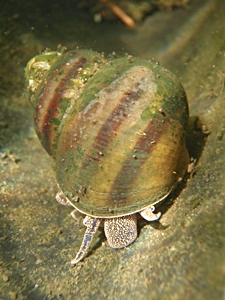 Danube river snail (Viviparus acerosus). Picture: © Alexander Mrkvicka, Vienna. |
 Shell of Viviparus contectus. Picture: H. Zell (Source). |
 Lister's river snail (Viviparus contectus): Plön, Schleswig-Hol- stein, Germany. Picture: Niklaszd (iNaturalist). |
|
 Common river snail (Viviparus viviparus). Picture: Marina Sutormina (iNaturalist): Stäket, Sweden. |
|
 Well camouflaged river snail (Viviparus viviparus). Picture: Roman D. (iNaturalist): Sum'ska obl., Ukraine. |
These snails are characterised by their spirally coiled, often globular shells and a well-developed, horny operculum that seals the shell aperture. They move slowly across the substrate and feed mainly on plant material, algae, and organic detritus. Some species are also capable of filtering suspended particles from the water they breathe – a behaviour more commonly associated with bivalves.
A distinctive feature of Viviparidae is their mode of reproduction: the females are ovoviviparous – they do not lay eggs, but give birth to fully developed young. The embryos hatch from their eggs inside the mother's body, thus protected from environmental hazards during development. In some species, sexual dimorphism is notable: for example, females are larger and more rounded in shape, while the male’s right tentacle is modified into a copulatory organ.
In Austria, three species are particularly common: Lister's river snail (Viviparus contectus), the Danube river snail (Viviparus acerosus), and the common river snail (Viviparus viviparus), which was named "Mollusc of the Year 2025" by the German Malacozoological Society.
![]() WoRMS: MolluscaBase eds. (2025):
Viviparidae J.E. GRAY 1847.
WoRMS: MolluscaBase eds. (2025):
Viviparidae J.E. GRAY 1847.
Lister's river snail (Viviparus contectus) mainly inhabits nutrient-rich lowland rivers and the shore zones of large lakes, where it slowly moves along the floor, grazing on aquatic vegetation and filtering fine suspended matter. It can remain in areas with abundant nutrients for extended periods of time. Viviparus contectus is also commonly found in turbid, overgrown, and algae-rich muddy ponds and pools. In addition, this species may occur in acidic bog ponds and marshes, different than most other Viviparidae.
As a typical member of the Viviparidae, Lister's river snail has a globular, dextrally coiled shell and a well-developed horny operculum, protecting its owner not only against predators but also against desiccation: therefore the snail can also be found in areas with an unstable water-line, where it usesu the operculum as a seal against drying-out or for hibernation. It is believed that river snails can live up to 13 years.
The thick-walled shell of Viviparus contectus can reach about 45 mm
in height and 30 mm in width, tapering to a pointed apex. The whorls are
strongly set-off, and the umbilicus is open. As with the Roman snail (Helix
pomatia), sinistral (left-coiled) specimens can rarely, but occasionally
be found (![]() Snail Kings). The shell is
usually greenish-brown to black with three reddish-brown bands. The snail's
head region is elongated into a short proboscis, with two tentacles located on
either side.
Snail Kings). The shell is
usually greenish-brown to black with three reddish-brown bands. The snail's
head region is elongated into a short proboscis, with two tentacles located on
either side.
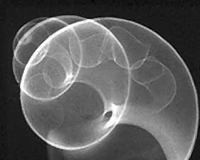 X-Ray picture of a river snail (Viviparus sp.) with growing juveniles. Picture: Prof. G. Ribi, Uni Zürich. |
 Juveniles of Viviparus contectus (5 mm). Picture: Schnecken und Muscheln. |
The reproductive biology of Viviparidae is particularly remarkable: they are viviparous, i.e. the females do not lay eggs, but instead, the embryos develop within egg capsules inside the mother’s body, nourished by a protein-rich fluid. During summer, the female can carry up to 30 embryos of different developmental stages. The oldest are born one at a time, each already bearing a shell of around 5 mm in size.
It is from this reproductive mode that the genus name Viviparus derives – Latin for "live-bearing". Strictly speaking, this is a form of ovoviviparity or lecithotrophic viviparity, which also occurs in other snail groups, such as some land-dwelling door snails (Clausiliidae).
The newborn juveniles have a hairy shell surface, which collects fine sediment particles – an effective camouflage that helps protect them from predators. The young snails are not only active on the substrate but are also occasionally seen crawling upside down along the water’s surface – a behaviour also observed in pond snails (Lymnaeidae).
Due to their very slow movement and near-sessile lifestyle, adult river snails often have shells covered with algae and sediment, which likewise provide them with even more effective camouflage.
Further Species:
In addition to Viviparus contectus, two further species occur in Central Europe:
The common river snail (Viviparus viviparus) is widespread and frequently found in suitable flowing and still waters. In 2025, it was named "Mollusc of the Year" by the German Malacozoological Society, since the species "is threatened both by the pollution of its aquatic habitats and by rising summer water temperatures, which lead to decreasing oxygen levels in the water" (SCHNIEBS, K. et al., 2025).
The Danube river snail (Viviparus acerosus), by contrast, is a character species of the Danube floodplains, where it occurs continuously downstream from Vienna. In Bavaria and other parts of Austria, the species is on the brink of extinction. Viviparus acerosus is difficult to distinguish from Viviparus viviparus, and the two species occasionally form hybrids. SCHNIEBS, K. et al. (2025) even suggest that they might represent two variants of the same species.
| Systematics: | |
|
Caenogastropoda Source: WoRMS: MolluscaBase eds. (2025): Littorinimorpha A.N. GOLIKOV & STAROBOGATOV, 1840. |
|
Systematik der Truncatelloidea Caenogastropoda > Littorinimorpha > Truncatelloidea |
|
|
Superfamily Truncatelloidea Source: WoRMS: MolluscaBase eds. (2025): Truncatelloidea J.E. GRAY, 1840. |
Under the broader grouping of Littorinimorpha, a large number of more advanced gastropod groups are classified within the Caenogastropoda. These include, besides the eponymous periwinkles (Littorinidae), marine families such as slipper snails (Calyptraeidae), cowries (Cypraeidae), conches (Strombidae) and tun snails (Tonnidae), as well as terrestrial groups like the round mouth snails (Pomatiidae), and many freshwater (limnic) groups, some of which will be the focus here.
Within the superfamily Truncatelloidea (see classification to the right), this includes faucet snails (Bithyniidae), spring snails (Bythinellidae) and mud snails (Tateidae), as well as Hydrobiidae, which include the mudflat snail (Peringia ulvae) (see The Wadden Sea).
Spring snails (Bythinellidae) are particularly noteworthy for their frequent endemism, often restricted to specific springs and streamlets. On the one hand, this has led to a very high species diversity within the group; on the other, these populations are often under threat whenever spring habitats are disturbed by construction or eutrophication.
The Tateidae in Central Europe are mainly represented by the New Zealand mud snail (Potamopyrgus antipodarum), which has immigrated in many regions and now serves as a bioindicator of a different kind: in contrast to many native freshwater snails, it is extremely undemanding. Thus, if a body of water hosts large numbers of New Zealand mud snails but very few other freshwater snails, this strongly suggests ecological impairment.
Finally, the Hydrobiidae comprise a wide range of small to very small operculate snail species living in marine and freshwater habitats, including the mudflat snail (Peringia ulvae) and the minute spring snails of the subfamily Belgrandiellinae. The classification on the right lists the Truncatelloidea groups covered on this website. The WoRMS database demonstrates just how complex and diverse these snail groups truly are.
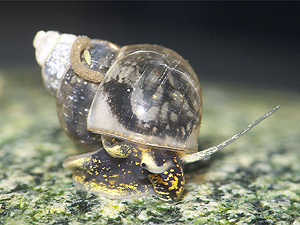 Common faucet snail (Bithynia tentaculata). Picture: Lars Peters. |
 Bithynia tentaculata with the characteristic aperture form and operculum. Picture: © Alexander Mrkvicka, Vienna. |
Bithyniid snails are noticeably smaller than river snails (Viviparidae) or, in particular, apple snails (Ampullariidae): the shell of an adult Bithynia tentaculata reaches a height of around 13 mm. The conical to ovoid shell is sealed by a thick, calcareous operculum, whose concentric structure is characteristic of the common faucet snail (Bithynia tentaculata, see image left). Bithyniids breathe with gills, enabling them to filter food particles from the water they draw in for respiration – in a similar way to Viviparus viviparus. In addition, they feed on decaying plant matter and other organic detritus.
Before laying its 20 to 40 eggs, the female cleans the undersides of stones, mussel shells and plant debris to remove algae. It then uses its foot to assemble the eggs into a gelatinous egg ribbon.
While several other Bithynia species are found throughout the Mediterranean region, only three species are native to Central Europe: the common faucet snail (Bithynia tentaculata), the bulbous faucet snail (Bithynia leachi), and the eastern faucet snail (Bithynia transsilvanica).
![]() WoRMS: MolluscaBase eds. (2025):
Bithyniidae J.E. GRAY 1847,
Bithynia transsilvanica (BIELZ,
1853).
WoRMS: MolluscaBase eds. (2025):
Bithyniidae J.E. GRAY 1847,
Bithynia transsilvanica (BIELZ,
1853).
![]() Faucet Snails
(Bithyniidae).
Faucet Snails
(Bithyniidae).
 Bythinella cylindrica. Picture: © Alexander Mrkvicka, Vienna. |
 Rhön spring snail (Bythinella compressa). Picture: © Alexander Mrkvicka, Vienna. |
 Spring snails (Bythinella compressa) on a tree leaf. Picture: © Alexander Mrkvicka, Vienna. |
Spring snails are adapted to consistently low temperatures (cold-stenothermic), as they live almost exclusively in springs, their upper outflows, and the headwaters of brooks. Their presence is considered an indicator of unpolluted spring water – in clean spring areas, densities can exceed several thousand individuals per square metre.
Many species in the genus Bythinella are endemic, occurring only in very small areas, often limited to a single spring. Due to this high degree of site fidelity, the family is both extremely speciose and particularly sensitive to environmental changes.
Spring snails are crenobionts: habitat specialists with a narrow ecological tolerance, and they respond to even minor deviations from their preferred conditions with population decline or local extinction. While they are highly adapted to the extreme and nutrient-poor spring environments, even small disturbances to the water balance, such as spring tapping or nutrient enrichment (eutrophication), can threaten entire populations.
A typical species found in Austria is the Austrian spring snail (Bythinella austriaca), which is found in alpine and Pannonian spring habitats. Though inconspicuous due to its minute size, it is an important bioindicator for intact groundwater ecosystems.
 Bavarian spring snail (Bythinella bavarica): Schussen Spring, Bavaria. Picture: Alexander Mrkvicka (Source). |
Distribution areas of different spring snail species (Bythinella) in Germany. |
 Austrian spring snail (Bythinella austriaca). Picture: Alexander Mrkvicka (iNaturalist): Baden, Austria. |
![]() WoRMS: MolluscaBase eds. (2025):
Bythinellidae LOCARD, 1893.
WoRMS: MolluscaBase eds. (2025):
Bythinellidae LOCARD, 1893.
![]() Spring Snails (Bythinellidae).
Spring Snails (Bythinellidae).
The Hydrobiidae family is very diverse. Apart from the tiny freshwater-living spring snails they also comprise the equally tiny mudflat snails (Peringia ulvae). Several subfamilies can be discerned (see system above).
 Klagenfurt spring snail (Graziana klagenfurtensis). Picture: © Alexander Mrkvicka, Vienna. |
|
 The orange coloured operculum, as well visible in this speci- men, tells Graziana and Belgrandiella apart from similar spe- cies of Bythinella (Bythinellidae). |
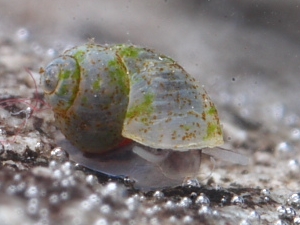 Spring snail (Belgrandiella wawrai). Picture: © Alexander Mrkvicka, Vienna. |
A particularly remarkable case is the Klagenfurt spring snail (Graziana klagenfurtensis), which was first described in 1994. It is found exclusively in the Sattnitz region south of Klagenfurt in Carinthia, Austria – it has never been recorded outside this area. All five or six springs within its known range are affected by environmental pollution and a lowering of the groundwater table.
For this reason, Graziana klagenfurtensis is listed on the Red List of Threatened Species and is classified as critically endangered due to the vulnerability of its habitat and the highly restricted nature of its range (see IUCN threat categories).
![]() Spring Snails
(Belgrandiellinae).
Spring Snails
(Belgrandiellinae).![]() Klagenfurt Spring Snail (Graziana
klagenfurtensis).
Klagenfurt Spring Snail (Graziana
klagenfurtensis).
![]() WoRMS: MolluscaBase eds. (2025):
Graziana klagenfurtensis HAASE, 1994.
WoRMS: MolluscaBase eds. (2025):
Graziana klagenfurtensis HAASE, 1994.
Literature
![]() REISCHÜTZ,
P. 2009. Graziana klagenfurtensis. In: IUCN 2011. IUCN Red List of
Threatened Species. Version 2011.1.
REISCHÜTZ,
P. 2009. Graziana klagenfurtensis. In: IUCN 2011. IUCN Red List of
Threatened Species. Version 2011.1.
![]() HAASE,
M., MILDNER, P. (1996): Hydrobiidae
(Gastropoda, Prosobranchia) Kärntens: Zur Verbreitung der Gattung Graziana.
Carinthia II 186 (106): S. 571 - 574. (
PDF).
HAASE,
M., MILDNER, P. (1996): Hydrobiidae
(Gastropoda, Prosobranchia) Kärntens: Zur Verbreitung der Gattung Graziana.
Carinthia II 186 (106): S. 571 - 574. (
PDF).
 Mudflat snail (Peringia ulvae): Côtes-d'Armor, Bretagne. Picture: Maëlan Adam (iNaturalist). |
 Mudflat snails (Peringia ulvae) on an oyster shell. Picture: Tiago Carrapiço (iNaturalist): Seixal, Portugal. |
Mudflat snails grow to just 3–6 mm in size and feed on fine organic particles. Through their faeces, they contribute to sediment formation in tidal mudflats. In the Baltic Sea, Peringia ulvae can tolerate brackish water with a salinity as low as 0.15% (~1.5 PSU). In some areas, up to 20,000 individuals can be found per square metre of mudflat!
Mudflat snails are not only among the smallest but, in principle, also among the fastest snails in the intertidal zone: though not when crawling in the conventional sense, where they reach a maximum of about 2 cm per minute. However, they can hang beneath the water surface and be carried along by tidal currents – a mode of transport, by which can reach speeds of up to 3.5 km/h.
Other genera within this subfamily inhabit aquifers, spring brooks, and drainage ditches, and are often only distinguishable under the microscope. Their high degree of specialisation makes them valuable bioindicators, but also particularly vulnerable species.
![]() Mudflat Snail (Peringia ulvae).
Mudflat Snail (Peringia ulvae).![]() Beachexplorer.org:
Factsheet: Peringia ulvae. (In German).
Beachexplorer.org:
Factsheet: Peringia ulvae. (In German).
![]() WoRMS: MolluscaBase eds. (2025):
Hydrobiidae W. STIMPSON, 1865.
WoRMS: MolluscaBase eds. (2025):
Hydrobiidae W. STIMPSON, 1865.
 New Zealand mud snail (Potamopyrgus antipodarum). Picture: Sylvain G. (iNaturalist): Haute-Garonne, Midi-Pyrénées, France. |
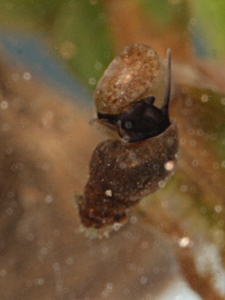 Potamopyrgus antipodarum. Picture: © Alexander Mrkvicka, Vienna. |
This species was most likely introduced to Europe in the 19th century in the ballast water of ships and has since spread throughout many rivers, canals, and lakes. Thanks to its low ecological requirements and high reproductive rate, it quickly outcompeted native species. Although P. antipodarum is technically ovoviviparous (giving birth to live young, see Viviparidae), it also has the ability to reproduce parthenogenetically, allowing rapid population growth under favourable conditions.
The resilience of the New Zealand mudsnail is remarkable: it tolerates current speeds of up to 0.5 m/s, salinity levels from 0–1.5% (~15 PSU, comparable to parts of the Baltic Sea), water temperatures from 0 to 34°C, and even survives dry periods of up to 24 hours or more than 50 days on moist surfaces. Moreover, like some freshwater limpets (e.g. Valvatidae), these snails can pass unharmed through the digestive systems of fish and birds – enabling long-distance dispersal. Several sources even claim that this tiny snail can crawl at a speed of over 1 metre per hour.
![]() How Fast are Snails? - A Comparison.
How Fast are Snails? - A Comparison.
Today, the New Zealand mudsnail is one of the most widespread freshwater snail species in Central European rivers – but with a downside: its mass occurrence is regarded as an indicator of ecological disturbance. Where this species dominates, more sensitive native snails have often already disappeared. It has thus been dubbed a "bioindicator of the wrong kind".
In some rivers, P. antipodarum may account for over 95% of the total invertebrate biomass, displacing native fauna and affecting predator populations such as trout. It is also extremely difficult to eradicate: even water treatment plants and hot water sterilisation methods often fail to eliminate it. In North America and Australia, it is now considered one of the most problematic invasive freshwater snail species.
![]() Schnecken und Muscheln:
Tateidae. (In German).
Schnecken und Muscheln:
Tateidae. (In German).![]() Mud Snails (Tateidae).
Mud Snails (Tateidae).![]() WoRMS: MolluscaBase eds. (2025):
Tateidae THIELE, 1925.
WoRMS: MolluscaBase eds. (2025):
Tateidae THIELE, 1925.
The families described below belong to the superfamily Cerithioidea and are therefore related to the marine horn snails (Cerithiidae). Since their systematic position within the Caenogastropoda has not yet been fully resolved, they are currently classified as "incertae sedis".
Horn snails occur worldwide in shallow marine waters on sandy substrates, in coral reefs with sand and algae, or on rocky ground. They are distributed across warm and temperate zones, with particular diversity in tropical regions. In the North Sea, the Netted Horn Snail (Bittium reticulatum), which measures about 0.5 to 1.5 cm in length, is commonly found (see: Seagrass Meadows). A few species of horn snails also inhabit mangrove forests. The Cerithiidae and their related groups represent yet another example of the multiple independent colonisations of freshwater habitats from the sea.
Horn snails geologically are a rather old gastropod group, fossils of which have been proven from as long ago as the Triassic age (about 250 bis 200 mio. years). Many species also are indicator fossils of the marine Tertiary period.
![]() Wikipedia:
Cerithiidae.
Wikipedia:
Cerithiidae.![]() WoRMS: MolluscaBase eds. (2025):
Cerithioidea J. FLEMING, 1822.
WoRMS: MolluscaBase eds. (2025):
Cerithioidea J. FLEMING, 1822.
 Red-rimmed Melania (Melanoides tuberculata). Picture: Frederico A. Sonntag (iNaturalist): São José de Piranhas, Brazil. |
Crown snails are dioecious (with separate sexes), but many species reproduce parthenogenetically, which means that in such populations, much like in the case of the New Zealand mudsnail (Potamopyrgus antipodarum, see above), almost all individuals are female. These snails are also ovoviviparous: females possess a specialised brood pouch in which they retain both the eggs and the developing embryos until the fully-formed juvenile snails hatch.
 Red-rimmed Melania (Melanoides tuberculata). Picture: Chris Rakowski (iNaturalist): Austin, Texas. |
In Central Europe, the most significant representative is the so-called red-rimmed Melania (Melanoides tuberculata), one of the most commonly kept aquarium snails. It is also known as the Indian or Malaysian trumpet snail, though its native range stretches from East Africa to Southeast Asia.
Melanoides tuberculata has been introduced to many parts of the world through improper disposal of aquarium snails. In the United States, it is considered a potential health risk to humans, as it can act as an intermediate host for various parasitic flukes. Moreover, due to its prolific reproduction and competition for food, it often displaces native snail species.
In Germany (e.g. Schwandorf, Bavaria) and Austria (e.g. Vöslau, Villach), the species has established itself in thermal springs and other artificially heated waters.
![]() Wikipedia:
Thiaridae,
Red-rimmed Melania.
Wikipedia:
Thiaridae,
Red-rimmed Melania.
![]() FALKNER,
G., FECHTER, R. (1990): Weichtiere, S. 128.
Mosaik-Verlag München.
FALKNER,
G., FECHTER, R. (1990): Weichtiere, S. 128.
Mosaik-Verlag München.
![]() GLÖER,
P., MEIER-BROOK,
C. (2003): Süßwassermollusken, S. 32. Deutscher Jugendbund für Naturbeobachtung
DJN, Hamburg.
GLÖER,
P., MEIER-BROOK,
C. (2003): Süßwassermollusken, S. 32. Deutscher Jugendbund für Naturbeobachtung
DJN, Hamburg.
 Short crown snail (Holandria holandrii). Picture: Alexander Mrkvicka (Source): Kulpa River, Slowenia. |
These small to large snails typically have ovate or narrowly conical shells with thick walls, slightly convex or stepped whorls, and either knobbly ribbing or smooth surfaces. The aperture often bears a groove along the lower edge, and the operculum has only a few spirals. The mantle edge is smooth. All species are dioecious (with separate sexes) and reproduce by laying eggs from which fully developed juveniles hatch. Melanopsids are grazers and feed primarily on algae.
 Pitch snail (Microcolpia daudebarti daudebartii). Picture: Alexander Mrkvicka (iNaturalist): Bükk mountains, Hungary. |
 Hot spring pitch snail (Microcolpia daudebartii acicularis). Picture: Alexander Mrkvicka (Quelle): Bad Vöslau, Lower Austria. |
Several melanopsid species are found in Central Europe. The Short Crown Snail (Holandria holandrii) is distributed across southeastern Europe and lives in fast-flowing rivers and streams in Slovenia and Croatia, feeding on microscopic algae.
The Pitch Snail (Microcolpia daudebartii) has spread from the western Black Sea region upstream along the Danube as far as eastern Austria and Slovakia. One of its subspecies, Microcolpia daudebartii acicularis, also known as the Thermal Pitch Snail, is restricted to thermal springs and warm waters. While numerous fossil relatives of the Thermal Pitch Snail are known from the Tertiary period, it is more likely that present-day Austrian populations are relicts of the interglacials, as there is no direct fossil record linking these to Tertiary species. During the interglacials, as fossil evidence suggests, the species once was spread as far as Bavaria and Thuringia. Today, comparable relict populations are found in Bad Vöslau and Bad Fischau in Lower Austria, as well as in Hungary’s Bükk Mountains.
Alongside the Thermal Nerite (Theodoxus prevostianus) and the Thermal Spring Snail (Bythinella pareyssii, see below), the Thermal Pitch Snail is therefore considered a species of special conservation concern.
![]() Pitch Snails
(Melanopsidae).
Pitch Snails
(Melanopsidae).![]() WoRMS: MolluscaBase eds. (2025):
Microcolpia daudebartii (PREVOST, 1821).
WoRMS: MolluscaBase eds. (2025):
Microcolpia daudebartii (PREVOST, 1821).![]() Wikipedia:
Kurze Kronenschnecke (In German),
Hot Spring Pitch Snail.
Wikipedia:
Kurze Kronenschnecke (In German),
Hot Spring Pitch Snail.
![]() Bad Vöslau:
Schneckenreservat - Kultur und Geschichte. (In German).
Bad Vöslau:
Schneckenreservat - Kultur und Geschichte. (In German).
![]() Wikipedia:
Naturdenkmal Hansybach. (In German).
Wikipedia:
Naturdenkmal Hansybach. (In German).
Heterobranchs (Heterobranchia), or “mixed gill snails”, form a highly diverse group of gastropods. Their classification has undergone multiple revisions in recent years. In general, Heterobranchia includes those snail groups in which the ancestral torsion of the body has been secondarily reversed during evolution. As a result of this detorsion, the main nerve cords (connectives) are no longer crossed. Because of this arrangement of parallel-running connectives, both the opisthobranchs (snails with gills posterior to the heart) and the pulmonates (air-breathing land and freshwater snails) were formerly grouped together as Euthyneura ("straight-nerved snails").
However, further phylogenetic studies based on molecular data have shown that not only these Euthyneura belong within Heterobranchia, but also a number of additional snail groups. Many of these are now grouped under the umbrella term “lower heterobranchs”, even though they were previously assigned to completely different taxonomic groups: for example, the valve snails (Valvatidae, see below) and staircase or sundial shells (Architectonicidae).
The systematics of these subgroups remains far from settled, and further changes can be expected as research continues.
![]() Marine Gastropoda -
Systematics: Heterobranchia.
Marine Gastropoda -
Systematics: Heterobranchia.
![]() WoRMS: MolluscaBase eds. (2025):
Heterobranchia BURMEISTER, 1837.
WoRMS: MolluscaBase eds. (2025):
Heterobranchia BURMEISTER, 1837.
 Common valve snail (Valvata piscinalis). Picture: Pierre Corbrion (iNaturalist). |
Systematically, molecular data place them among the Heterobranchia, although they hold an autonomous position and cannot be assigned to any of the major subordinate groups. Together with other such independent lineages, they are grouped as the so-called “Lower Heterobranchia” – the presence of an operculum suggests they may have diverged early in heterobranch evolution.
![]() Source:
WoRMS: MolluscaBase eds. (2025):
Valvatidae GRAY, 1840.
Source:
WoRMS: MolluscaBase eds. (2025):
Valvatidae GRAY, 1840.
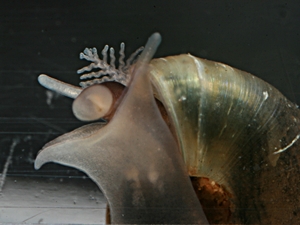 Head of the common valve snail (Valvata piscinalis). Clearly visible: front part of the foot, long snout (proboscis), and feather-like gill. Picture: © Alexander Mrkvicka, Vienna. |
The tentacles are long and taper at the base, attached to a well-defined head with a distinct snout or proboscis. The foot is flat, split into two lobes at the front and rounded at the back.
Valve snails are detritus feeders, consuming decomposing organic material. They themselves are an important food source for fish, which has led to Valvata piscinalis being nicknamed the “roach snail” or “tench snail”. Remarkably, these small snails, like the New Zealand mud snail (Potamopyrgus antipodarum), have been proven to survive the passage through a fish’s digestive tract. Thus, they not only serve as a food source, but are also distributed by their predators.
Much like Potamopyrgus, Valvata piscinalis is also relatively tolerant of chemical pollution. It may therefore serve as a "negative indicator species", since it often dominates in waters where more sensitive snail species have already disappeared.
 Lister's river snail (Viviparus contectus): Klagenfurt, Carinthia, Austria. Picture: Alexander Mrkvicka (iNaturalist). |
 Thermal spring snail (Belgrandiella pareyssii). Picture: Alexander Mrkvicka (iNaturalist): Bad Vöslau, Lower Austria. |
Other species act as warning signs in their own right: the New Zealand mud snail (Potamopyrgus antipodarum) and the valve snail (Valvata piscinalis) continue to grow in population even when more demanding species have already declined or vanished. Their mass presence often indicates that the water quality no longer meets the needs of more sensitive native species, for instance, as a result of eutrophication caused by agricultural runoff, or construction work in or near water bodies.
By contrast, highly specialised snail species such as spring snails of the genera Bythinella, Belgrandiella, and Graziana occur only at very specific sites under equally specific conditions. These are not so much bioindicators in the narrower sense, but rather target species for conservation: their presence signals old, largely unspoilt habitats – their disappearance, in turn, marks the creeping loss of such habitats. These snail species are particularly vulnerable when they are endemic, found in only one or a handful of locations: Such small-scale distribution areas make them especially sensitive to threats like water pollution, eutrophication, or habitat disturbance by human activity.
In this way, freshwater snails offer not only fascinating insights into molluscan evolution, but also help us to better understand – and protect – the health of our aquatic environments.
After all, it is the rare and sometimes truly unique species of animals and plants that make our environment and our home so special. And once lost, they cannot be brought back.
Latest Change: 28.06.2025 (Robert Nordsieck).